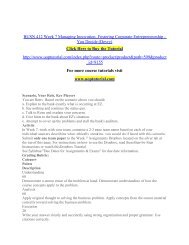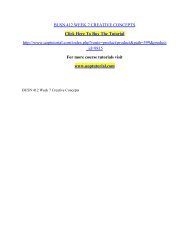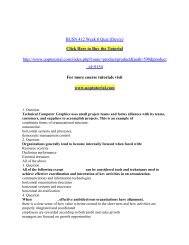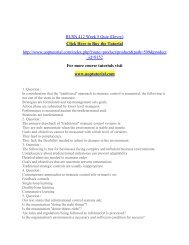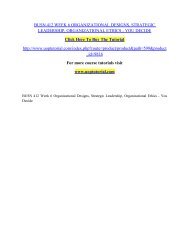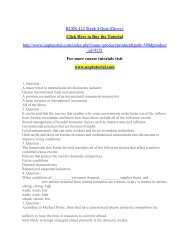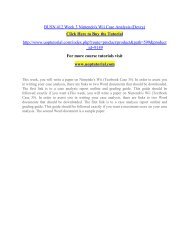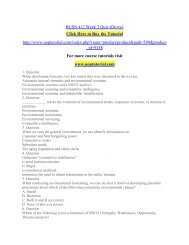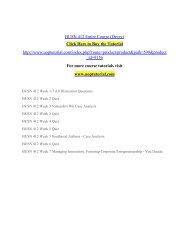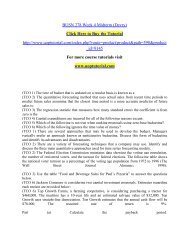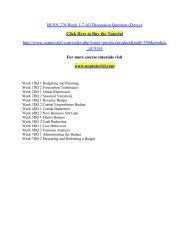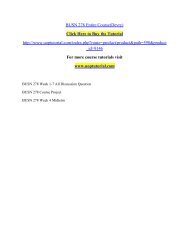BUSN 412 Week 3 Quiz
You also want an ePaper? Increase the reach of your titles
YUMPU automatically turns print PDFs into web optimized ePapers that Google loves.
<strong>BUSN</strong> <strong>412</strong> <strong>Week</strong> 3 <strong>Quiz</strong> (Devry)<br />
Click Here to Buy the Tutorial<br />
http://www.uoptutorial.com/index.php?route=product/product&path=599&product<br />
_id=9150<br />
For more course tutorials visit<br />
www.uoptutorial.com<br />
1. Question :<br />
Information technology, such as email, has increased in organizations over the years, which has<br />
helped to:<br />
Restrict social network growth<br />
Create smaller social networks<br />
Communicate information efficiently<br />
Make more effective use of time in every situation<br />
2. Question :<br />
The following characterizes the creation of knowledge assets:<br />
High upfront costs and subsequent high variable costs<br />
High fixed costs and high variable costs<br />
Low upfront costs and high variable costs<br />
High upfront costs and low variable costs<br />
3. Question :<br />
John Steele was asked to take over a project after the entire team left his organization. The term<br />
that describes his ability to reconstruct what the team had accomplished through reading emails<br />
exchanged by the previous team's members can be considered:<br />
Inefficient use of information management<br />
Using tacit knowledge<br />
Usage of project knowledge<br />
Using explicit knowledge<br />
4. Question :<br />
The following are examples of how intellectual property can be managed except:<br />
Converting explicit knowledge to tacit knowledge<br />
Copyrights and trademarks<br />
Patents<br />
Contracts with confidentiality and noncompete clauses<br />
5. Question :<br />
Dynamic capabilities include all of the following except:<br />
Learning and innovating<br />
The ability of an organization to challenge the conventional industry in its industry and market
Becoming more efficient in operational processes<br />
Continuously adopting new ways of serving the evolving needs of the market<br />
6. Question :<br />
When there are few segments, the emphasis on process design is low, and the major functional<br />
areas of concern are general management and finance, this can be said to be the ____________<br />
stage of the industry life cycle.<br />
growth<br />
maturity<br />
decline<br />
introduction<br />
7. Question :<br />
When there is(are) ____________________, we should likely pursue a harvest strategy:<br />
decline in the market life cycle<br />
high growth<br />
strong competitive advantage<br />
mergers and acquisitions<br />
8. Question :<br />
During the decline stage of the industry life cycle, __________ refers to obtaining as much profit<br />
as possible and requires that costs be decreased quickly.<br />
maintaining<br />
harvesting<br />
exiting<br />
consolidating<br />
9. Question :<br />
Research shows that the following are all strategies used by firms engaged in successful<br />
turnarounds except:<br />
Asset and cost surgery<br />
Selective product and market pruning<br />
Global expansion<br />
Piecemeal productivity improvements<br />
10. Question :<br />
It can be said that during a turnaround, piecemeal productivity improvements do not involve:<br />
Expansion of a firm's product market scope<br />
Business process reengineering<br />
Increased capacity utilization<br />
Benchmarking<br />
11. Question :<br />
Use the value chain as a framework to explain how a firm can achieve a competitive advantage<br />
of overall cost leadership.



